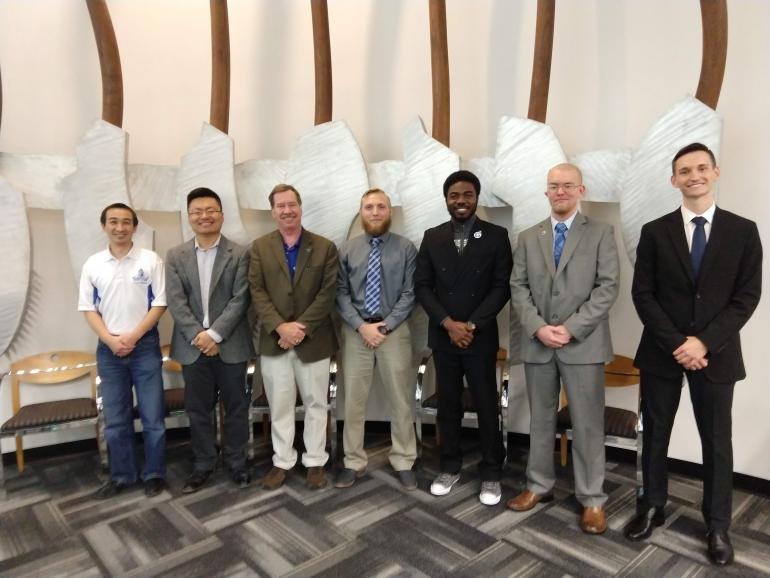Utility Navigation
Menu
menu
FOR IMMEDIATE RELEASE: November 4, 2019
For more information
Glenville State College
Public Relations Department
(304) 462-4115
GLENVILLE, WV – On Saturday, October 19, seven members of the Glenville State College Alpha Iota Chapter of Chi Beta Phi attended the 72nd National Conference of Chi Beta Phi. The conference was hosted by the Rho Chapter of the organization at West Liberty University, located in West Liberty, West Virginia. The faculty members of Alpha Iota Chapter present were Larry Baker (Co-Advisor of the Chapter), Wenwen Du (Co-Advisor of the Chapter), James Maku, and Pai Song. Student members who attended the conference were, Brian T. Moore (Chapter President), Preston Allison (Chapter Vice President), and Jacob Petry.
During the morning session the chapters present gave reports on their activities for the past year. In the afternoon session, five posters and seven oral presentations of student research were evaluated. Glenville State College students gave two of the oral presentations.
Moore spoke about how diastema is an erect herb distributed from Mexico southward into northern South America within the subtribe Gloxiniinae (Gesneriaceae). Diastema can be classified by five finger-like nectary lobes, racemose paired flower cyme, and fruit dehiscence. Throughout history Diastema has notoriously been classified incorrectly, and is currently undergoing taxonomic investigation. Diastema racemiferum, the type specimen for the genus, was used for morphological comparison. The specimen was collected from the Island of Salanga, Ecuador.
His research has focused primarily on examining the changes within the genus across its geographic range with a focus on Central America (specifically Panama). This genus is polyphyletic in Panama with most collections belonging to a new segregate genus Pseudodiastema. Morphological and molecular studies were used. Morphological variance was quantified from available Ecuador and Columbian specimens. Morphological studies focused on reproductive characteristics while making use of vegetative features as well. Molecular studies were performed to build a better understanding of the evolution of the species and genus. Moore’s previous work is being utilized to separate the genera currently attributed to Diastema. Future results from the molecular studies will provide more concise answers when building Diastema’s phylogeny. The research will aid in the taxonomic investigation of Diastema.
Allison presented findings regarding how much impact sea water temperature has on the Mesoglea of Exaiptasia pallida. Increased seawater temperature is a known stressor that induces coral bleaching. Previous research by other scientists has shown that temperature stress in various species of corals alters expression of genes that regulate extracellular matrix deposition and cytoskeleton rearrangement. As the extracellular matrix aides in regulation of cell signaling leading to apoptosis and autophagy, Allison investigated how increased sea water temperature impacted the mesoglea of the symbiotic sea anemone Exaiptasia pallida. He used E. pallida because they possess a symbiotic relationship with zooxanthellae and bleach like coral. The mesoglea of cnidarians is a gelatinous acellular mixture composed of mainly collagen, glycoproteins, and various other extracellular matrix proteins. Since collagen is the prominent component of the mesoglea, a common histological stain, Russell-Movat Pentachrome stain (RMP), can be used to observe changes in the mesoglea and various other extracellular matrix proteins via microscopy. RMP stains collagen yellow, elastin fibers and nuclei black, fibrinoid intense red, mucins blue to green, and muscle red. Anemones are heat stressed at temperatures of 25℃ to 30℃ from one to 48 hours, embedded in paraffin wax, sectioned, and stained with RMP. Histological differences between control and heat-treated anemones are detectable particularly in a reduction in the amount of collagen stained in heat treated anemones relative to controls. His research investigated a time series of heat stress to determine the onset of the differences in collagen staining and how that correlates with apoptosis. The goal of his research is to help elucidate mechanisms underlying temperature-induced bleaching in symbiotic anemones and coral.
In the award ceremony at the end of the conference, GSC’s Alpha Iota Chapter was recognized as the Most Outstanding Chapter and Moore received second place in the Oral Presentations Category.
“Glenville State College is doing an excellent job providing our students with opportunities to participate and compete at a high level in STEM-related research,” stated Co-Advisors Baker and Du.
Chi Beta Phi is a scientific honorary for undergraduate students. An affiliate of The American Association for the Advancement of Science since 1935, the object of the organization is to promote interest in science and to give recognition to scholarly attainment in science. Members participate together in events of scientific interest and wholesome fellowship. Membership is open to students in various scientific disciplines and to faculty members at colleges with local chapters. The Alpha Iota Chapter at Glenville State College was chartered in 1964 and has been active since.

